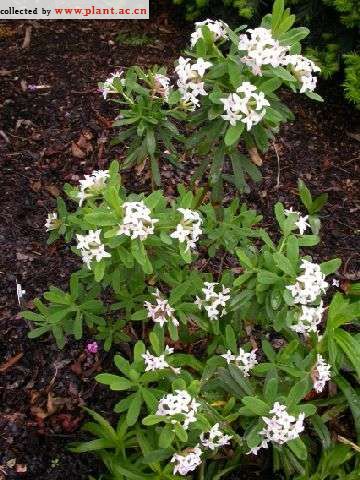Daphne x burkwoodii SomersetDaphne
科:瑞香科
Family:Thymelaeaceae
属:瑞香属
common name:Daphne
introduce:Plant Type: Deciduous shrub
Family: Thymelaeaceae
Missouri Native: No
Native Range: None
Height: 2 to 3 feet
Spread: 4 to 5 feet
Bloom Time: May
Bloom Color: Creamy white to pale pink
Sun: Part shade (only)
Water: Medium moisture
Maintenance: High
General Culture:
Best grown in moist, rich, sandy-humusy, well-drained soils with a neutral pH in part shade. Consider raised plantings in areas of heavy clay soils to insure good drainage. Also best when planted in locations protected from winter winds and full sun. Benefits from a summer mulch or ground cover which will often help keep roots cool. Do not allow soils to dry out. Often slow to establish and is best left undisturbed once planted.
Noteworthy Characteristics:
Daphnes are well known for their intensely fragrant flowers. This daphne hybrid cultivar is a slow-growing, densely-branched, deciduous shrub which typically grows 2-3 (less frequently to 4) tall with a rounded, mounding habit. Features clusters of extremely fragrant, creamy white to pale blush-pink flowers in late spring which are followed by tiny red drupes (1/3" wide) in fall. Small, dense, oblong, bright green leaves (to 1 1/2" long) often persist well into December with no fall color. Somerset is a cross between D. cneorum and D. caucasica.
Problems:
Although many nurseries consider this plant to be winter hardy to USDA Zone 4, daphnes in the St. Louis area often suffer significant winter injury in severe winters, particularly if improperly planted in locations exposed to cold winter winds and full sun. Plants weakened by winter injury are more susceptible to disease problems. Potential diseases include leaf spots, canker, twig blight, crown rot and virus. Potential insect pests include aphids, mealy bugs and scale. Plants can be temperamental. Michael Dirr reports that daphnes sometimes die very quickly for "no explicable reason."
Uses:
A small, rounded shrub which is quite effective in smaller gardens. Plant in shrub borders, woodland gardens or incorporate into foundation plantings. Has good specimen value.
